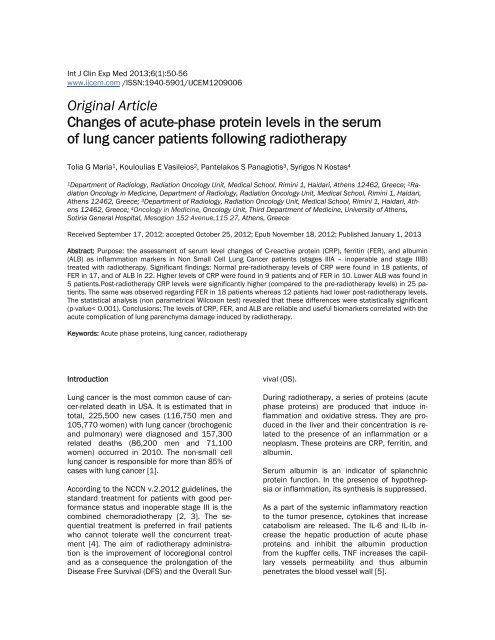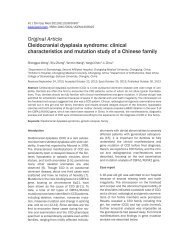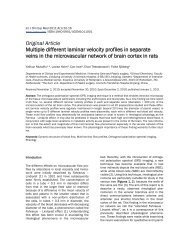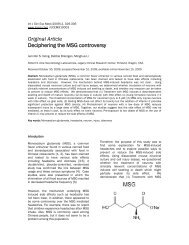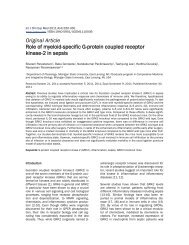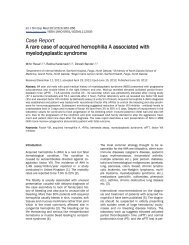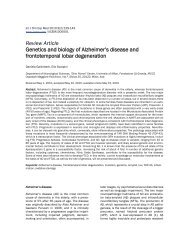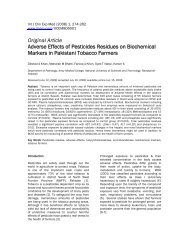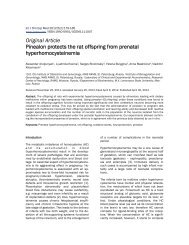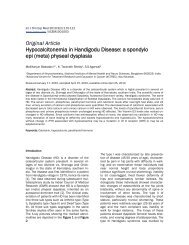Changes of acute-phase protein levels in the serum of lung cancer ...
Changes of acute-phase protein levels in the serum of lung cancer ...
Changes of acute-phase protein levels in the serum of lung cancer ...
Create successful ePaper yourself
Turn your PDF publications into a flip-book with our unique Google optimized e-Paper software.
Int J Cl<strong>in</strong> Exp Med 2013;6(1):50-56<br />
www.ijcem.com /ISSN:1940-5901/IJCEM1209006<br />
Orig<strong>in</strong>al Article<br />
<strong>Changes</strong> <strong>of</strong> <strong>acute</strong>-<strong>phase</strong> <strong>prote<strong>in</strong></strong> <strong>levels</strong> <strong>in</strong> <strong>the</strong> <strong>serum</strong><br />
<strong>of</strong> <strong>lung</strong> <strong>cancer</strong> patients follow<strong>in</strong>g radio<strong>the</strong>rapy<br />
Tolia G Maria 1 , Kouloulias E Vasileios 2 , Pantelakos S Panagiotis 3 , Syrigos N Kostas 4<br />
1Department <strong>of</strong> Radiology, Radiation Oncology Unit, Medical School, Rim<strong>in</strong>i 1, Haidari, A<strong>the</strong>ns 12462, Greece; 2 Radiation<br />
Oncology <strong>in</strong> Medic<strong>in</strong>e, Department <strong>of</strong> Radiology, Radiation Oncology Unit, Medical School, Rim<strong>in</strong>i 1, Haidari,<br />
A<strong>the</strong>ns 12462, Greece; 3 Department <strong>of</strong> Radiology, Radiation Oncology Unit, Medical School, Rim<strong>in</strong>i 1, Haidari, A<strong>the</strong>ns<br />
12462, Greece; 4 Oncology <strong>in</strong> Medic<strong>in</strong>e, Oncology Unit, Third Department <strong>of</strong> Medic<strong>in</strong>e, University <strong>of</strong> A<strong>the</strong>ns,<br />
Sotiria General Hospital, Mesogion 152 Avenue,115 27, A<strong>the</strong>ns, Greece<br />
Received September 17, 2012; accepted October 25, 2012; Epub November 18, 2012; Published January 1, 2013<br />
Abstract: Purpose: <strong>the</strong> assessment <strong>of</strong> <strong>serum</strong> level changes <strong>of</strong> C-reactive <strong>prote<strong>in</strong></strong> (CRP), ferrit<strong>in</strong> (FER), and album<strong>in</strong><br />
(ALB) as <strong>in</strong>flammation markers <strong>in</strong> Non Small Cell Lung Cancer patients (stages ΙΙΙΑ – <strong>in</strong>operable and stage ΙΙΙΒ)<br />
treated with radio<strong>the</strong>rapy. Significant f<strong>in</strong>d<strong>in</strong>gs: Normal pre-radio<strong>the</strong>rapy <strong>levels</strong> <strong>of</strong> CRP were found <strong>in</strong> 18 patients, <strong>of</strong><br />
FER <strong>in</strong> 17, and <strong>of</strong> ALB <strong>in</strong> 22. Higher <strong>levels</strong> <strong>of</strong> CRP were found <strong>in</strong> 9 patients and <strong>of</strong> FER <strong>in</strong> 10. Lower ALB was found <strong>in</strong><br />
5 patients.Post-radio<strong>the</strong>rapy CRP <strong>levels</strong> were significantly higher (compared to <strong>the</strong> pre-radio<strong>the</strong>rapy <strong>levels</strong>) <strong>in</strong> 25 patients.<br />
The same was observed regard<strong>in</strong>g FER <strong>in</strong> 18 patients whereas 12 patients had lower post-radio<strong>the</strong>rapy <strong>levels</strong>.<br />
The statistical analysis (non parametrical Wilcoxon test) revealed that <strong>the</strong>se differences were statistically significant<br />
(p-value< 0.001). Conclusions: The <strong>levels</strong> <strong>of</strong> CRP, FER, and ALB are reliable and useful biomarkers correlated with <strong>the</strong><br />
<strong>acute</strong> complication <strong>of</strong> <strong>lung</strong> parenchyma damage <strong>in</strong>duced by radio<strong>the</strong>rapy.<br />
Keywords: Acute <strong>phase</strong> <strong>prote<strong>in</strong></strong>s, <strong>lung</strong> <strong>cancer</strong>, radio<strong>the</strong>rapy<br />
Introduction<br />
Lung <strong>cancer</strong> is <strong>the</strong> most common cause <strong>of</strong> <strong>cancer</strong>-related<br />
death <strong>in</strong> USA. It is estimated that <strong>in</strong><br />
total, 225,500 new cases (116,750 men and<br />
105,770 women) with <strong>lung</strong> <strong>cancer</strong> (brochogenic<br />
and pulmonary) were diagnosed and 157,300<br />
related deaths (86,200 men and 71,100<br />
women) occurred <strong>in</strong> 2010. The non-small cell<br />
<strong>lung</strong> <strong>cancer</strong> is responsible for more than 85% <strong>of</strong><br />
cases with <strong>lung</strong> <strong>cancer</strong> [1].<br />
Accord<strong>in</strong>g to <strong>the</strong> ΝCCN v.2.2012 guidel<strong>in</strong>es, <strong>the</strong><br />
standard treatment for patients with good performance<br />
status and <strong>in</strong>operable stage III is <strong>the</strong><br />
comb<strong>in</strong>ed chemoradio<strong>the</strong>rapy [2, 3]. The sequential<br />
treatment is preferred <strong>in</strong> frail patients<br />
who cannot tolerate well <strong>the</strong> concurrent treatment<br />
[4]. The aim <strong>of</strong> radio<strong>the</strong>rapy adm<strong>in</strong>istration<br />
is <strong>the</strong> improvement <strong>of</strong> locoregional control<br />
and as a consequence <strong>the</strong> prolongation <strong>of</strong> <strong>the</strong><br />
Disease Free Survival (DFS) and <strong>the</strong> Overall Survival<br />
(OS).<br />
Dur<strong>in</strong>g radio<strong>the</strong>rapy, a series <strong>of</strong> <strong>prote<strong>in</strong></strong>s (<strong>acute</strong><br />
<strong>phase</strong> <strong>prote<strong>in</strong></strong>s) are produced that <strong>in</strong>duce <strong>in</strong>flammation<br />
and oxidative stress. They are produced<br />
<strong>in</strong> <strong>the</strong> liver and <strong>the</strong>ir concentration is related<br />
to <strong>the</strong> presence <strong>of</strong> an <strong>in</strong>flammation or a<br />
neoplasm. These <strong>prote<strong>in</strong></strong>s are CRP, ferrit<strong>in</strong>, and<br />
album<strong>in</strong>.<br />
Serum album<strong>in</strong> is an <strong>in</strong>dicator <strong>of</strong> splanchnic<br />
<strong>prote<strong>in</strong></strong> function. In <strong>the</strong> presence <strong>of</strong> hypothrepsia<br />
or <strong>in</strong>flammation, its syn<strong>the</strong>sis is suppressed.<br />
As a part <strong>of</strong> <strong>the</strong> systemic <strong>in</strong>flammatory reaction<br />
to <strong>the</strong> tumor presence, cytok<strong>in</strong>es that <strong>in</strong>crease<br />
catabolism are released. The ΙL-6 and IL-Ib <strong>in</strong>crease<br />
<strong>the</strong> hepatic production <strong>of</strong> <strong>acute</strong> <strong>phase</strong><br />
<strong>prote<strong>in</strong></strong>s and <strong>in</strong>hibit <strong>the</strong> album<strong>in</strong> production<br />
from <strong>the</strong> kupffer cells. ΤΝF <strong>in</strong>creases <strong>the</strong> capillary<br />
vessels permeability and thus album<strong>in</strong><br />
penetrates <strong>the</strong> blood vessel wall [5].
Acute-<strong>phase</strong> <strong>prote<strong>in</strong></strong>, <strong>serum</strong>, <strong>lung</strong> <strong>cancer</strong>, radio<strong>the</strong>rapy<br />
CRP is an <strong>acute</strong> reaction <strong>in</strong>dicator and because<br />
<strong>of</strong> its rapid mobility it provides reliable <strong>in</strong>formation<br />
on <strong>the</strong> current <strong>in</strong>flammatory status. Its relation<br />
with cytok<strong>in</strong>es and its possible functional<br />
role have given a significant dimension to its<br />
cl<strong>in</strong>ical use as a parameter <strong>of</strong> active <strong>in</strong>flammation<br />
[6]. Ferrit<strong>in</strong> is a ferrum b<strong>in</strong>d<strong>in</strong>g <strong>prote<strong>in</strong></strong> and<br />
<strong>in</strong> patients with <strong>lung</strong> <strong>cancer</strong> is elevated [7, 8].<br />
The raised <strong>levels</strong> <strong>of</strong> ferrit<strong>in</strong> are due to <strong>in</strong>flammation<br />
ra<strong>the</strong>r to <strong>in</strong>creased ferrum concentration<br />
[9]. It can be detected <strong>in</strong> samples from <strong>the</strong> airways<br />
such as bronchoalveolar lavage (BAL),<br />
bronchial secretions, and <strong>in</strong> pleural effusion<br />
from metastatic <strong>cancer</strong> [10]. In an extensive<br />
research <strong>in</strong> <strong>the</strong> PubMed/MEDLINE no o<strong>the</strong>r<br />
study was found assess<strong>in</strong>g <strong>the</strong> alteration <strong>of</strong> <strong>the</strong><br />
<strong>levels</strong> <strong>of</strong> <strong>the</strong> above mentioned <strong>prote<strong>in</strong></strong>s <strong>in</strong> <strong>the</strong><br />
<strong>serum</strong> <strong>of</strong> patients suffer<strong>in</strong>g from stage III <strong>lung</strong><br />
<strong>cancer</strong> treated with external radio<strong>the</strong>rapy. The<br />
aim <strong>of</strong> <strong>the</strong> present study was to assess <strong>the</strong> <strong>serum</strong><br />
<strong>levels</strong> <strong>of</strong> CRP, album<strong>in</strong>, and ferrit<strong>in</strong> before<br />
and 2 months follow<strong>in</strong>g treatment.<br />
Material and methods<br />
Study design – <strong>in</strong>clusion criteria<br />
The primary aim <strong>of</strong> <strong>the</strong> present prospective<br />
study was to assess <strong>the</strong> alteration <strong>of</strong> CRP, ferrit<strong>in</strong>,<br />
and album<strong>in</strong> <strong>levels</strong> <strong>in</strong> <strong>the</strong> peripheral blood<br />
<strong>of</strong> patients with <strong>lung</strong> <strong>cancer</strong>, before and 2<br />
months follow<strong>in</strong>g 3-Dimensional Conformal Radio<strong>the</strong>rapy<br />
(3DCRT). The study was approved by<br />
<strong>the</strong> Medical School Ethics committee <strong>of</strong> <strong>the</strong> Kapodistrian<br />
University <strong>of</strong> A<strong>the</strong>ns. All patients were<br />
<strong>in</strong>formed regard<strong>in</strong>g <strong>the</strong>ir participation <strong>in</strong> <strong>the</strong><br />
study. The <strong>in</strong>clusion criteria were: a) Zubrod<br />
performance status 0 to 2. b) Primary non-small<br />
cell <strong>lung</strong> <strong>cancer</strong>, stages ΙΙΙΑ (<strong>in</strong>operable due to<br />
comorbidity) and ΙΙΙB. c) Absence <strong>of</strong> <strong>acute</strong> <strong>in</strong>flammation<br />
signs.<br />
Pre-treatment workup<br />
Thorough history was taken from all participat<strong>in</strong>g<br />
patients followed by cl<strong>in</strong>ical exam<strong>in</strong>ation.<br />
The absence <strong>of</strong> systemic <strong>in</strong>flammatory, <strong>in</strong>fectious,<br />
or rheumatic disease was <strong>the</strong>n confirmed.<br />
Complete hematologic, biochemical, and radiological<br />
test<strong>in</strong>g was followed. The latter <strong>in</strong>cluded<br />
chest and upper abdom<strong>in</strong>al (with contrast) CTscan<br />
and bra<strong>in</strong> MRI with iv gadol<strong>in</strong>ium adm<strong>in</strong>istration.<br />
The above exam<strong>in</strong>ations were part <strong>of</strong><br />
<strong>the</strong> disease stag<strong>in</strong>g <strong>in</strong> order to exclude distant<br />
metastases and active <strong>in</strong>flammation. The diagnosis<br />
<strong>of</strong> <strong>the</strong> malignancy was confirmed with<br />
cytology or histopathology after tak<strong>in</strong>g a sample<br />
from <strong>the</strong> primary malignancy.<br />
Radio<strong>the</strong>rapy simulation<br />
The patients were submitted to virtual simulation,<br />
<strong>in</strong> sup<strong>in</strong>e position, us<strong>in</strong>g <strong>the</strong> w<strong>in</strong>gboard<br />
special immobiliz<strong>in</strong>g system. This way, <strong>the</strong> patients’<br />
hands were rest<strong>in</strong>g securely above and<br />
beh<strong>in</strong>d <strong>the</strong> head <strong>in</strong> order <strong>the</strong> tattoos that align<br />
<strong>the</strong> chest to be del<strong>in</strong>eated and <strong>the</strong> radiation<br />
physist to be able to use oblique fields to m<strong>in</strong>imize<br />
<strong>the</strong> radiation dose <strong>in</strong> <strong>the</strong> surround<strong>in</strong>g sensitive<br />
normal tissues.<br />
Radio<strong>the</strong>rapy plann<strong>in</strong>g<br />
For radio<strong>the</strong>rapy plann<strong>in</strong>g, CT-scan was performed<br />
<strong>in</strong> order to cover <strong>the</strong> anatomical area<br />
extend<strong>in</strong>g from <strong>the</strong> 6 th cervical vertebra to <strong>the</strong><br />
mid abdomen. This was conducted with and<br />
without contrast (due to its effect to <strong>the</strong> tissue<br />
heteroge<strong>in</strong>ity requir<strong>in</strong>g correction). The Ct-scan<br />
slices had a thickness <strong>of</strong> 5 mm and <strong>the</strong> data<br />
were transferred to <strong>the</strong> Prosoma ® Treatment<br />
Plann<strong>in</strong>g System via DICOM network.<br />
Organs at risk – Target volume del<strong>in</strong>eation<br />
This plann<strong>in</strong>g was performed us<strong>in</strong>g <strong>the</strong> CT slices<br />
derived from <strong>the</strong> Prosoma Treatment Plann<strong>in</strong>g<br />
System simulation. When atelectasis was present<br />
or <strong>in</strong> case <strong>of</strong> allergy PET scan was performed.<br />
The tumor targets were def<strong>in</strong>ed accord<strong>in</strong>g<br />
to <strong>the</strong> ICRU reports 50, 62 [11]. As macroscopically<br />
visible tumor target (Gross tumor volume<br />
– GTV) def<strong>in</strong>ed <strong>the</strong> primary tumor, <strong>the</strong> affected<br />
lymph node with maximum diameter<br />
greater than 1 cm (<strong>in</strong> <strong>the</strong> short axis), <strong>the</strong> <strong>in</strong>creased<br />
metabolic activity <strong>in</strong> PET scan, and <strong>the</strong><br />
presence <strong>of</strong> <strong>cancer</strong> cells <strong>in</strong> <strong>the</strong> mediast<strong>in</strong>oscopy.<br />
The cl<strong>in</strong>ical tumor target (cl<strong>in</strong>ical target<br />
volume - CTV) is related to <strong>the</strong> microscopic<br />
spread <strong>of</strong> <strong>the</strong> disease and it is usually considered<br />
as 1-1.5 cm around GTV. The geometric<br />
tumor target (plann<strong>in</strong>g target volume - PTV) is<br />
<strong>the</strong> marg<strong>in</strong> <strong>of</strong> set up error cover<strong>in</strong>g <strong>the</strong> <strong>in</strong>accuracies<br />
<strong>of</strong> everyday position<strong>in</strong>g and those derived<br />
from <strong>the</strong> <strong>in</strong>ternal organs movement around <strong>the</strong><br />
Internal Target Volume and it is usually considered<br />
as 0.5-1.5 cm around CTV. The Organs at<br />
Risk (OARs) as well as <strong>the</strong> tolerance doses,<br />
were determ<strong>in</strong>ed accord<strong>in</strong>g to <strong>the</strong> ICRU Report<br />
62. In detail: Sp<strong>in</strong>al cord (Max Dose po<strong>in</strong>t) ≤ 50<br />
51 Int J Cl<strong>in</strong> Exp Med 2013;6(1):50-56
Acute-<strong>phase</strong> <strong>prote<strong>in</strong></strong>, <strong>serum</strong>, <strong>lung</strong> <strong>cancer</strong>, radio<strong>the</strong>rapy<br />
Gy; Lung V20 ≤ 30-35%; Heart V60 ≤ 30%, Mean<br />
Dose ≤ 35 Gy; Esophagus Mean Dose ≤ 34 Gy,<br />
Max ≤ 105 % <strong>of</strong> prescription dose; Brachial<br />
plexus ≤ 66 Gy.<br />
Dose description and Plan evaluation<br />
In all cases <strong>the</strong> radio<strong>the</strong>rapy technique used<br />
was <strong>the</strong> 3-Dimensional Conformal Radio<strong>the</strong>rapy<br />
(3DCRT). Due to <strong>the</strong> fact that <strong>the</strong> optimal radio<strong>the</strong>rapy<br />
dose has not yet been def<strong>in</strong>ed and it is<br />
still under <strong>in</strong>vestigation, it was decided to adm<strong>in</strong>ister<br />
a biologically equivalent dose equal to<br />
60 Gy <strong>in</strong> 13 daily photon radiation sessions accord<strong>in</strong>g<br />
to a hyp<strong>of</strong>ractionated schedule from<br />
Monday to Friday. The 95% <strong>of</strong> <strong>the</strong> PTV had to be<br />
covered by <strong>the</strong> 95%-110% <strong>of</strong> <strong>the</strong> total dose. The<br />
treatment was performed with l<strong>in</strong>ear accelerator,<br />
and energies <strong>of</strong> 6 to 15 ΜV were used <strong>in</strong><br />
order to optimize <strong>the</strong> dose distribution. In case<br />
<strong>of</strong> air gap, <strong>the</strong> energy <strong>of</strong> 6 MV was preferred,<br />
while <strong>in</strong> large mediast<strong>in</strong>al lymph node masses<br />
or <strong>in</strong> tumors attached to <strong>the</strong> thoracic wall a<br />
higher energy was usually preferred to improve<br />
<strong>the</strong> dose distribution.<br />
Chemo<strong>the</strong>rapy was also adm<strong>in</strong>istered to <strong>the</strong><br />
patients studied accord<strong>in</strong>g to <strong>the</strong> current<br />
NCCN® (National Comprehensive Cancer Network)<br />
guidel<strong>in</strong>es. The treatment plann<strong>in</strong>g was<br />
performed us<strong>in</strong>g <strong>the</strong> Eclipse treatment plann<strong>in</strong>g<br />
system (Varian Medical Systems, United<br />
States) that <strong>in</strong>cludes <strong>the</strong> Pencil Beam algorithm<br />
to calculate <strong>the</strong> radiation dose. The evaluation<br />
<strong>of</strong> <strong>the</strong> treatment plann<strong>in</strong>g was performed us<strong>in</strong>g<br />
<strong>the</strong> distribution <strong>of</strong> <strong>the</strong> isodose curves and <strong>the</strong><br />
Dose Volume Histogramms (DVHs).<br />
Measurement <strong>of</strong> <strong>acute</strong> <strong>phase</strong> <strong>serum</strong> <strong>prote<strong>in</strong></strong>s<br />
Peripheral blood sample was taken before <strong>the</strong><br />
beg<strong>in</strong>n<strong>in</strong>g <strong>of</strong> radiation <strong>the</strong>rapy and 2 months<br />
follow<strong>in</strong>g its completion. The samples were centrifuged<br />
and <strong>serum</strong> CRP and ferrit<strong>in</strong> were measured<br />
us<strong>in</strong>g nephelometric method (Beckman<br />
Coulter, Image Immunochemistry System,<br />
U.S.A.), while album<strong>in</strong> was measured us<strong>in</strong>g<br />
photometric method.<br />
Follow-up<br />
The patients’ follow-up at 2 months’ <strong>in</strong>tervals<br />
<strong>in</strong>cluded: medical history, cl<strong>in</strong>ical exam<strong>in</strong>ation,<br />
haemotological and biochemical test<strong>in</strong>g, thoracic<br />
and upper abdom<strong>in</strong>al CT-scan, with contrast.<br />
At <strong>the</strong> first 2-month follow-up <strong>in</strong>terval, <strong>the</strong><br />
values <strong>of</strong> CRP, album<strong>in</strong>, and ferrit<strong>in</strong> were measured<br />
as well.<br />
Statistical analysis<br />
The values <strong>of</strong> CRP, album<strong>in</strong>, and ferrit<strong>in</strong> were<br />
expressed as means ± standard deviations. The<br />
statistical comparisons <strong>of</strong> <strong>the</strong> above values before<br />
and 2 months after <strong>the</strong> completion <strong>of</strong> radio<strong>the</strong>rapy<br />
were performed us<strong>in</strong>g <strong>the</strong> Wilcoxon rank<br />
non parametric test. Statistical significance was<br />
accepted at <strong>the</strong> p
Acute-<strong>phase</strong> <strong>prote<strong>in</strong></strong>, <strong>serum</strong>, <strong>lung</strong> <strong>cancer</strong>, radio<strong>the</strong>rapy<br />
Table 1. Demographics and histology type <strong>of</strong> all patients <strong>in</strong>cluded <strong>in</strong> <strong>the</strong> study.<br />
Case No Gender Stage Histology type Age<br />
1 Male ΙIIB ADENOCARCINOMA 65<br />
2 Male ΙΙΙΑ SQUAMOUS CELL CARCINOMA 73<br />
3 Male ΙΙΙΒ SQUAMOUS CELL CARCINOMA 64<br />
4 Male ΙΙΙΑ SQUAMOUS CELL CARCINOMA 58<br />
5 Male ΙΙΙΑ SQUAMOUS CELL CARCINOMA 61<br />
6 Male ΙΙΙΒ SQUAMOUS CELL CARCINOMA 72<br />
7 Male ΙΙΙΒ ADENOCARCINOMA 82<br />
8 Male ΙIIB ADENOCARCINOMA 88<br />
9 Male IIIB ADENOCARCINOMA 75<br />
10 Male ΙΙΙΒ SQUAMOUS CELL CARCINOMA 82<br />
11 Male ΙΙΙΒ ADENOCARCINOMA 79<br />
12 Male ΙΙΙΑ ADENOCARCINOMA 53<br />
13 Female ΙΙΙΒ ADENOCARCINOMA 67<br />
14 Male ΙΙΙΑ ADENOCARCINOMA 55<br />
15 Male ΙΙΙΑ ADENOCARCINOMA 62<br />
16 Female ΙIIB SQUAMOUS CELL CARCINOMA 67<br />
17 Female ΙΙΙΑ SQUAMOUS CELL CARCINOMA 65<br />
18 Female ΙΙΙΒ ADENOCARCINOMA 60<br />
19 Male ΙΙΙΒ ADENOCARCINOMA 74<br />
20 Male ΙΙΙΒ ADENOCARCINOMA 88<br />
21 Male ΙΙΙΒ ADENOCARCINOMA 78<br />
22 Male ΙΙΙΒ ADENOCARCINOMA 55<br />
23 Male ΙΙΙΑ SQUAMOUS CELL CARCINOMA 79<br />
24 Male ΙΙΙΒ SQUAMOUS CELL CARCINOMA 73<br />
25 Male ΙΙΙΒ SQUAMOUS CELL CARCINOMA 75<br />
26 Male ΙΙΙΑ ADENOCARCINOMA 72<br />
27 Male ΙΙΙΒ ADENOCARCINOMA 76<br />
to <strong>the</strong> <strong>acute</strong> adverse event <strong>of</strong> <strong>lung</strong> parenchyma<br />
damage caused by radio<strong>the</strong>rapy. The present<br />
study suggests that <strong>the</strong> values <strong>of</strong> CRP and ferrit<strong>in</strong><br />
are statistically significantly elevated <strong>in</strong> <strong>the</strong><br />
immediate post-radio<strong>the</strong>rapy <strong>in</strong>terval compared<br />
to <strong>the</strong> pre-radio<strong>the</strong>rapy values (p
Acute-<strong>phase</strong> <strong>prote<strong>in</strong></strong>, <strong>serum</strong>, <strong>lung</strong> <strong>cancer</strong>, radio<strong>the</strong>rapy<br />
Table 2. Values <strong>of</strong> CRP, Ferrit<strong>in</strong>, and Album<strong>in</strong> before and after radio<strong>the</strong>rapy<br />
CRP preRT CRP postRT Ferrit<strong>in</strong><br />
pre RT<br />
Ferrit<strong>in</strong><br />
post RT<br />
Αlbum<strong>in</strong><br />
pre RT<br />
Album<strong>in</strong><br />
post RT<br />
3,91 8,3 80 264 4,1 3,6<br />
2,96 7,77 93 232 4,5 4<br />
1,39 4,56 102 254 5,1 4,7<br />
6,1 9,4 409 603 3,5 3,2<br />
3,48 5,28 320 623 5,2 4<br />
1,83 7,3 206 523 4,9 3,9<br />
2,26 4,9 229 456 5,1 3,8<br />
7,23 11,4 520 678 3,4 3<br />
2,97 5,01 256 345 3,6 3,2<br />
1,01 6,5 308 469 4,7 4,4<br />
5,7 8,1 432 567 3,7 3,2<br />
2,51 5,8 107 378 5,5 5<br />
3,01 7,3 187 327 3,8 3<br />
3,4 5,2 345 476 3,7 3,3<br />
7,8 11,2 543 675 3,3 3,1<br />
6,1 12,1 456 689 3,9 3,6<br />
4,8 8,3 339 567 4 3,5<br />
3,7 5,8 123 234 5,2 5<br />
2,8 7,3 324 499 4,6 4<br />
1,37 6,7 287 356 5,3 4,9<br />
3,9 8,6 136 321 5,2 4,1<br />
4,6 7,9 401 662 4,7 4,3<br />
6,9 12,3 458 638 3,2 3<br />
7,2 9,7 467 642 3,6 3,4<br />
4,4 7,6 321 543 4,7 4,3<br />
7,8 9,9 567 765 3,7 3,4<br />
9,3 14,1 578 654 3,3 3,1<br />
Table 3. Statistical analysis <strong>of</strong> <strong>the</strong> differences between <strong>the</strong> values pre- and post-radio<strong>the</strong>rapy<br />
CRP_pre CRP_post P<br />
4,4 (2,2) 8,1 (2,5)
Acute-<strong>phase</strong> <strong>prote<strong>in</strong></strong>, <strong>serum</strong>, <strong>lung</strong> <strong>cancer</strong>, radio<strong>the</strong>rapy<br />
studies had similar outcomes.<br />
In <strong>the</strong> present study, <strong>the</strong> disease stage was <strong>the</strong><br />
same <strong>in</strong> all patients and <strong>the</strong> tumor load comparable.<br />
The tissue reaction aga<strong>in</strong>st <strong>the</strong> tumor and<br />
radio<strong>the</strong>rapy is expected to be similar as well.<br />
These are some <strong>of</strong> <strong>the</strong> strengths <strong>of</strong> <strong>the</strong> present<br />
study. However, <strong>the</strong> conclusions <strong>of</strong> <strong>the</strong> present<br />
study with regard to <strong>the</strong> prognostic value <strong>of</strong> <strong>the</strong><br />
<strong>in</strong>vestigated <strong>prote<strong>in</strong></strong>s are weakened by <strong>the</strong><br />
small number <strong>of</strong> patients and <strong>the</strong> relatively<br />
short follow-up.<br />
Acknowledgements<br />
There is no f<strong>in</strong>ancial support for <strong>the</strong> present<br />
work.<br />
Address correspondence to: Dr. Tolia Maria, Radiation<br />
Oncologist, Consultant University Hospital,<br />
Attikon A<strong>the</strong>ns Greece. Tel.: +30-210-5831860;<br />
Fax: +30-210-5326418; E-mail: mariatolia1@gmail.com<br />
References<br />
[1] Jemal A, Siegel R, Xu J, Ward E. Cancer Statistics,<br />
2010. CA Cancer J Cl<strong>in</strong> 2010; 60: 277-<br />
300.<br />
[2] Auper<strong>in</strong> A, Le Pechoux C, Rolland E, Curran WJ,<br />
Furuse K, Fournel P, Belderbos J, Clamon G,<br />
Ulut<strong>in</strong> HC, Paulus R, Yamanaka T, Bozonnat<br />
MC, Uitterhoeve A, Wang X, Stewart L, Arriagada<br />
R, Burdett S, Pignon JP. Meta-analysis<br />
<strong>of</strong> concomitant versus sequential radiochemo<strong>the</strong>rapy<br />
<strong>in</strong> locally advanced NSCLC. J Cl<strong>in</strong> Oncol<br />
2010; 28: 2181-2190.<br />
[3] O’Rourke N, Roque’ I,Figuls M, Farre’ Bernado’,<br />
Macbeth F. Concurrent chemoradio<strong>the</strong>rapy <strong>in</strong><br />
NSCLC. Cochrane Database Syst Rev 2010.<br />
[4] Sause W, Kolesar P, Taylor S IV, Johnson D,<br />
Liv<strong>in</strong>gston R, Komaki R, Emami B, Curran W Jr,<br />
Byhardt R, Dar AR, Turrisi A 3rd. F<strong>in</strong>al results <strong>of</strong><br />
<strong>phase</strong> III trial <strong>in</strong> regionally advanced unresectable<br />
NCSLC: Radiation Therapy Oncology<br />
Group. Chest 2000; 117: 358-364.<br />
[5] Simons JP, Schols AM, Buurman WA, Wouters<br />
EF. Weight loss and low body cell mass <strong>in</strong><br />
males with <strong>lung</strong> <strong>cancer</strong>: relationship with systemic<br />
<strong>in</strong>flammation, <strong>acute</strong>-<strong>phase</strong> response,<br />
rest<strong>in</strong>g energy expenditure, and catabolic and<br />
anabolic hormones. Cl<strong>in</strong> Sci (Lond) 1999; 97:<br />
215-223.<br />
[6] Van Leeuwen MA, Van Rijswijk MH. Acute<br />
<strong>phase</strong> <strong>prote<strong>in</strong></strong>s <strong>in</strong> <strong>the</strong> monitor<strong>in</strong>g <strong>of</strong> <strong>in</strong>flammatory<br />
disorders. Baillieres Cl<strong>in</strong> Rheumatol 1994;<br />
8: 531-552.<br />
[7] Macchia V, Mariano A, Cavalcanti M, Coppa A,<br />
Cecere C, Fraioli G, Elia S, Ferrante G. Tumor<br />
markers and <strong>lung</strong> <strong>cancer</strong>: correlation between<br />
<strong>serum</strong> and bronchial secretion <strong>levels</strong> <strong>of</strong> CEA,<br />
TPA, CanAg CA-50, NSE and ferrit<strong>in</strong>. Int J Biol<br />
Markers 1987; 2: 151-156.<br />
[8] Fracchia A, Ubbiali A, El Bitar O, Pacetti M, Sommariva<br />
E, Arregh<strong>in</strong>i M Longh<strong>in</strong>i E, Bonalumi GP.<br />
A comparative study on ferrit<strong>in</strong> concentration <strong>in</strong><br />
<strong>serum</strong> and bilateral bronchoalveolar lavage<br />
fluid <strong>of</strong> patients with peripheral <strong>lung</strong> <strong>cancer</strong><br />
versus control subjects. Oncology 1999; 56:<br />
181-188.<br />
[9] Kukulj S, Jaganjac M, Boranic M, Krizanac S,<br />
Santic Z, Poljak-Blazi M. Altered iron metabolism,<br />
<strong>in</strong>flammation, transferr<strong>in</strong> receptors, and<br />
ferrit<strong>in</strong> expression <strong>in</strong> non-small-cell <strong>lung</strong> <strong>cancer</strong>.<br />
Med Oncol 2010; 27: 268-277.<br />
[10] Franciolli M, Rosenmund A. Iron and ironb<strong>in</strong>d<strong>in</strong>g<br />
<strong>prote<strong>in</strong></strong>s <strong>in</strong> <strong>the</strong> differential diagnosis <strong>of</strong><br />
pleural effusion. Schweiz Med Wochenschr<br />
1989; 119: 785-790.<br />
[11] ICRU Report 50, 62: Prescrib<strong>in</strong>g, Record<strong>in</strong>g and<br />
Report<strong>in</strong>g Photon Beam Therapy. 1993, 1999.<br />
[12] Scott HR, McMillan DC, Forrest LM, Brown DJ,<br />
McArdle CS, Milroy R. The systemic <strong>in</strong>flammatory<br />
response, weight loss, performance status<br />
and survival <strong>in</strong> patients with <strong>in</strong>operable nonsmall<br />
cell <strong>lung</strong> <strong>cancer</strong>. Br J Cancer 2002; 87:<br />
264-267.<br />
[13] McMillan DC, Elahi MM, Sattar N, Angerson WJ,<br />
Johnstone J, McArdle CS. Measurement <strong>of</strong> <strong>the</strong><br />
systemic <strong>in</strong>flammatory response predicts <strong>cancer</strong>-specific<br />
and non-<strong>cancer</strong> survival <strong>in</strong> patients<br />
with <strong>cancer</strong>. Nutr Cancer 2001; 41: 64-69.<br />
[14] Schumacher K, Haensch W, Roefzaad C, Schlag<br />
PM. Prognostic significance <strong>of</strong> activated CD8<br />
(+) T cell <strong>in</strong>filtrations with<strong>in</strong> esophageal carc<strong>in</strong>omas.<br />
Cancer Res 2001; 61: 3932-3936.<br />
[15] Kushner I, Rzewnicki D, Samols D. What does<br />
m<strong>in</strong>or elevation <strong>of</strong> C-reactive <strong>prote<strong>in</strong></strong> signify?<br />
Am J Med 2006; 119: 166 e117-128.<br />
[16] Forrest LM, McMillan DC, McArdle CS, Angerson<br />
WJ, Dunlop DJ. Evaluation <strong>of</strong> cumulative prognostic<br />
scores based on <strong>the</strong> systemic <strong>in</strong>flammatory<br />
response <strong>in</strong> patients with <strong>in</strong>operable nonsmall-cell<br />
<strong>lung</strong> <strong>cancer</strong>. Br J Cancer 2003; 89:<br />
1028-1030.<br />
[17] Ikeda M, Natsugoe S, Ueno S, Baba M, Aikou T.<br />
Significant host- and tumorrelated factors for<br />
predict<strong>in</strong>g prognosis <strong>in</strong> patients with esophageal<br />
carc<strong>in</strong>oma. Ann Surg 2003; 238: 197-202.<br />
[18] Nozoe T, Saeki H, Sugimachi K. Significance <strong>of</strong><br />
preoperative elevation <strong>of</strong> <strong>serum</strong> C-reactive <strong>prote<strong>in</strong></strong><br />
as an <strong>in</strong>dicator <strong>of</strong> prognosis <strong>in</strong> esophageal<br />
carc<strong>in</strong>oma. Am J Surg 2001; 182: 197-201.<br />
[19] Shimada H, Nabeya Y, Okazumi S, Matsubara<br />
H, Shiratori T, Aoki T, Sugaya M, Miyazawa Y,<br />
Hayashi H, Miyazaki S, Ochiai T. Elevation <strong>of</strong><br />
preoperative <strong>serum</strong> Creactive <strong>prote<strong>in</strong></strong> level is<br />
related to poor prognosis <strong>in</strong> esophageal<br />
squamous cell carc<strong>in</strong>oma. J Surg Oncol 2003;<br />
83: 248-252.<br />
[20] Crumley AB, McMillan DC, McKernan M,<br />
55 Int J Cl<strong>in</strong> Exp Med 2013;6(1):50-56
Acute-<strong>phase</strong> <strong>prote<strong>in</strong></strong>, <strong>serum</strong>, <strong>lung</strong> <strong>cancer</strong>, radio<strong>the</strong>rapy<br />
McDonald AC, Stuart RC. Evaluation <strong>of</strong> an <strong>in</strong>flammation-based<br />
prognostic score <strong>in</strong> patients<br />
with <strong>in</strong>operable gastrooesophageal <strong>cancer</strong>. Br J<br />
Cancer 2006; 94: 637-641.<br />
[21] Chang-Yu Wang, M<strong>in</strong>g-Jang Hsieh, Yi-Chun Chiu,<br />
Shau-Hsuan Li, Hurng-Wern Huang, Fu-M<strong>in</strong><br />
Fang, Yu-Jie Huang. Higher <strong>serum</strong> C-reactive<br />
<strong>prote<strong>in</strong></strong> concentration and hypoalbum<strong>in</strong>emia<br />
are poor prognostic <strong>in</strong>dicators <strong>in</strong> patients with<br />
esophageal <strong>cancer</strong> undergo<strong>in</strong>g radio<strong>the</strong>rapy.<br />
Radio<strong>the</strong>r Oncol 2009; 92: 270-275.<br />
[22] McMillan DC, Crozier JE, Canna K, Angerson<br />
WJ, McArdle CS. Evaluation <strong>of</strong> an <strong>in</strong>flammationbased<br />
prognostic score (GPS) <strong>in</strong> patients undergo<strong>in</strong>g<br />
resection for colon and rectal <strong>cancer</strong>. Int<br />
J Colorectal Dis 2007; 22: 881-886.<br />
[23] Hashimoto K, Ikeda Y, Korenaga D, Tanoue K,<br />
Hamatake M, Kawasaki K, Yamaoka T, Iwatani<br />
Y, Akazawa K, Takenaka K. The impact <strong>of</strong> preoperative<br />
<strong>serum</strong> C reactive <strong>prote<strong>in</strong></strong> on <strong>the</strong> prognosis<br />
<strong>of</strong> patients with hepatocellular carc<strong>in</strong>oma.<br />
Cancer 2005; 103: 1856-1864.<br />
[24] Kodama J, Miyagi Y, Seki N, Tokumo K, Yosh<strong>in</strong>ouchi<br />
M, Kobashi Y, Okuda H, Kudo T. Serum<br />
C-reactive <strong>prote<strong>in</strong></strong> as a prognostic factor <strong>in</strong> patients<br />
with epi<strong>the</strong>lial ovarian <strong>cancer</strong>. Eur J Obstet<br />
Gynecol Reprod Biol 1999; 82: 107-110.<br />
[25] Nakanishi H, Araki N, Kudawara I, Kuratsu S,<br />
Matsum<strong>in</strong>e A, Mano M, Naka N, Myoui A, Ueda<br />
T, Yoshikawa H. Cl<strong>in</strong>ical implications <strong>of</strong> <strong>serum</strong><br />
Creactive <strong>prote<strong>in</strong></strong> <strong>levels</strong> <strong>in</strong> malignant fibrous<br />
histiocytoma. Int J Cancer 2002; 99: 167-170.<br />
[26] Murri AM, Bartlett JM, Canney PA, Doughty JC,<br />
Wilson C, McMillan DC. Evaluation <strong>of</strong> an <strong>in</strong>flammation-based<br />
prognostic score (GPS) <strong>in</strong> patients<br />
with metastatic breast <strong>cancer</strong>. Br J Cancer<br />
2006; 94: 227-230.<br />
[27] Ramsey S, Lamb GW, Aitchison M, Graham J,<br />
McMillan DC. Evaluation <strong>of</strong> an <strong>in</strong>flammationbased<br />
prognostic score <strong>in</strong> patients with metastatic<br />
renal <strong>cancer</strong>. Cancer 2007; 109: 205-<br />
212.<br />
[28] Glen P, Jamieson NB, McMillan DC, Carter<br />
R, Imrie CW, McKay CJ. Evaluation <strong>of</strong> an<br />
<strong>in</strong>flammation-based prognostic score <strong>in</strong><br />
patients with <strong>in</strong>operable pancreatic <strong>cancer</strong>.<br />
Pancreatology 2006; 6: 450-453.<br />
56 Int J Cl<strong>in</strong> Exp Med 2013;6(1):50-56


